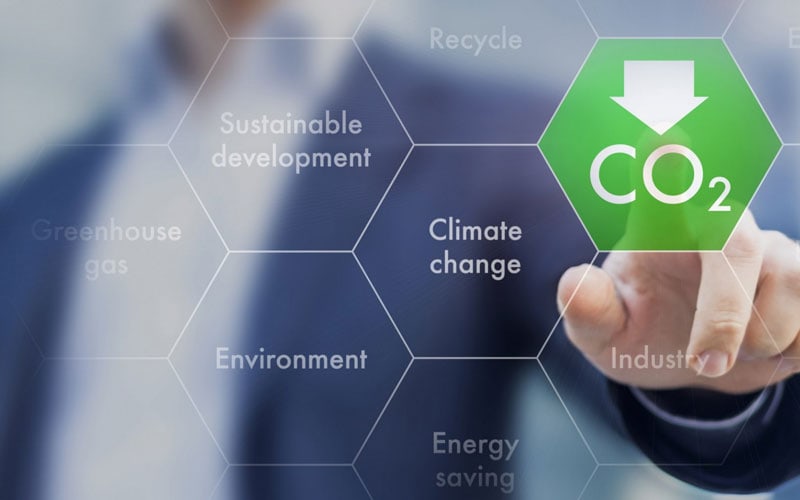
Carbon emission is a big problem in the world. As the atmosphere continues to fill up with carbon, the global temperature continues to rise and cause extreme weather events in the world. That problem will likely accelerate in the future if nothing is done.
Unfortunately, a massive amount of pollution occurs in the world from people and businesses. In the United States alone, 5.2 million metric tons of carbon dioxide were sent into the environment in 2020.
The good news is that you have options as a business that will help you do your part to help.
If you’re looking for ways to reduce carbon emissions in your business, this post will help. Below are 10 great tactics you can use to create a greener business and help the environment.
Businesses Can Reduce Their Carbon Emissions
1. Start Recycling
The number one way for businesses to reduce their impact on the environment is to reduce the amount of trash that ends up in a landfill. Even though no real production happens at a landfill, they still produce byproducts. Carbon dioxide gets released as the garbage sits in a pile and degrades.
Recycling and reusing the products you don’t use anymore makes more sense. You can recycle everything from food waste to paper in an office. Put recycling bins in common areas and encourage employees to put their waste in those bins.
The same is also true for larger things you throw out. Don’t just rent a dumpster and send it to a landfill. Reach out to your local government and private companies to see if they can recycle and repurpose anything you throw out.
2. Maintain Your Equipment
You’re probably going to produce some form of output if you need to use machines to run your company. Those machines produce exhaust and use electricity, so there’s no getting around some emissions.
However, there is a difference between the emissions from a well-maintained machine and one that isn’t in good shape. Poor quality equipment has a more challenging time getting the job done. In many cases, that means more byproducts.
That’s why it pays to maintain all your equipment. Create a maintenance schedule that looks for common machine problems and performs regular maintenance tasks. Doing this will help your machine runs optimally and produce less waste.
3. Invest in Renewable Energy
Renewable energy isn’t something only available to homes and large energy providers. There are companies across the globe investing in solar panels to put them on their roofs. As a result, they use a lot of solar energy instead of drawing power from dirty energy.
You can also go this route if you have space for solar panels. Roofs are normally flat on office buildings, so they’re a great place to put a solar installation. If you have issues with your roof, you can do it on the ground if you have enough land next to your office.
Doing this will offset your energy consumption and reduce your reliance on the grid. Even if you can’t fulfill all your power needs, you can offset much of it and reduce your carbon footprint in the process.
4. Encourage Remote Work
Do you have employees that spend their days in front of computers? If so, it’s probably a waste to have everyone in the office at all times. Most people don’t need to be at a physical office to get all their work accomplished.
It makes more sense to let people work from home if they want to. You can let people work from home full-time and come in for meetings, or you can offer people the ability to work from home a few days per week.
That means there are fewer people driving cars and wasting time in traffic. If you cut down on the number of people in the office, that also means you don’t need a huge office space.
You can drastically reduce your carbon emissions by downsizing your business property and moving to a smaller building.
5. Watch Your Supply Chain
The amount of emissions you put into the environment doesn’t only include what you do in your physical location. It also includes the businesses you work with when purchasing products and supplies.
Look as far into your supply chain as possible to see how your vendors treat the environment. Do they engage in sustainable practices or not do anything to offset the carbon they emit?
Look for major problems in your supply chain when you want to reduce your carbon footprint. Try to eliminate vendors that produce waste and switch to other companies that take sustainability seriously.
You may not be able to cut all waste from your supply chain, but you can reduce it by a lot.
6. Buy Second-Hand
It’s tempting to go all-out when furnishing a new office and buy everything new. You want to give the best impression possible and look like you have nothing but the best. The question is, does this actually matter that much?
In most cases, the answer is no. All your employees and guests care about is having a nice experience. They probably won’t investigate to see if you have the best of everything.
That’s why it makes more sense to look for second-hand products. That includes things like desks, chairs, decor, and computer equipment. Just be sure that the things you buy work before you commit to the purchase.
You’ll save money and not contribute to second-hand goods heading to the landfill.
7. Invest in Carbon Capture
If you run a lot of machinery in your business, the chances are good you have an exhaust system that expels those emissions outside. You don’t want to expose your workers to those problems, so it makes sense to do things this way.
However, this also expels a lot of byproducts into the atmosphere. Luckily, you have options today that will help you reduce your carbon footprint.
You can invest in a product like the Climeworks DAC that helps capture your carbon output. Direct air capture devices will capture carbon in the atmosphere to remove it from circulation. From there, you can safely dispose of your byproducts without the same impact on the environment.
8. Improve Office Energy Efficiency
Just powering your office will produce a lot of carbon. You have lighting, computer equipment, lunchroom appliances, and much more. It’s a problem if all of your things use a ton of power.
Look at what you currently have in your office to see if you can purchase a more energy-efficient alternative. Take light bulbs, for instance. You can switch to LED bulbs to save a lot of energy and ensure your light bulbs last a long time.
You can also invest in energy-efficient appliances in your kitchen and other areas. These appliances are designed to use less energy, so they’ll reduce your building’s power usage long-term.
9. Stop Using Paper
Paper is one of the most wasteful parts of a business. Many companies still print everything, which means they use a lot of tree products and have scrap lying around everywhere.
Most companies don’t need to do this anymore. Now that you have computers that can store digital documents, you can keep everything on your computer systems and remove paper from your business.
Even if you can’t remove all paper because of legal requirements, you should still remove as much paper as possible. On top of that, digitize any paper documents you receive in the mail and recycle the mail after you finish digitizing everything.
10. Consider Virtual Meetings
Do you have customers all over the world? If so, there’s no getting around the need to meet those customers to flesh out the details of deals.
The old way to do this was to travel across the country to have meetings in person. While this does work fine, it does waste a ton of fuel and contribute to carbon emissions. This is especially true if you use air travel a lot and spend a lot of time on planes.
None of that is necessary these days with virtual meetings. You can quickly set up a video call with people globally instead of wasting time and resources traveling to a single location. Use video meetings as much as possible to cut the amount of business travel your company does.
It’s Within Your Power to Reduce Your Carbon Emissions
It’s no secret that global warming is a real thing that will change how the world works. The question is, do you accept what will happen or do everything possible to reduce your impact on the environment and make the world better?
The good news is that there are many things you can do as a business to reduce your carbon emissions. Follow the advice above in your business to do your part for the environment.
Do you want to learn more tips that will help you improve the other parts of your business? Learn more advice by checking out more posts on the blog.







